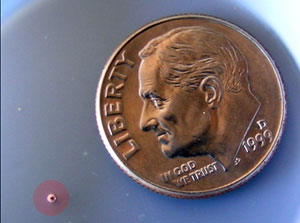Broke Your CFL? Don't Panic!

The typical dose of mercury in a CFL is about the size
of a pen tip (circled in red), and these doses
have been getting smaller and smaller.
(Photo provided by EPA.)Australia has already begun to phase out the incandescent light bulb, and the energy legislation recently signed by President Bush has begun that process in the United States. Every time I turn around, it seems, someone is handing me a brand new compact fluorescent light (CFL) to advance the cause of energy efficiency and help save the planet. CFLs are becoming ubiquitous in households all over California. We taught them in the pages of Home Energy all the time. And that's a good thing, right?
Brandy Bridges, of Ellsworth, Maine may not think so. A cleaning company quoted her a price of $2,000 to clean her house after she broke a CFL.
The benefits of CFLs are many--they use about 75% less energy than incandescents and last up to ten times longer. Replacing a 75W incandescent with an 18W CFL will save you about $46 in electricity costs over the life of the bulb, and that is at current electricity prices, which no doubt will go up, making today's CFLs an even better deal. Energy Star CFLs (www.energystar.gov/cfls) won't flicker, give warmer light, and there are a variety of them, from the ubiquitous A-line bulb, to candelabras.
But, and it's a big but, CFLs won't give light without mercury. The average CFL on the shelf at your local hardware store has about 4 mg of mercury in it. Mercury vapor is harmful to humans, and there is enough mercury accumulated in some of the fish we eat to make this Californian think twice about ordering salmon for dinner.
